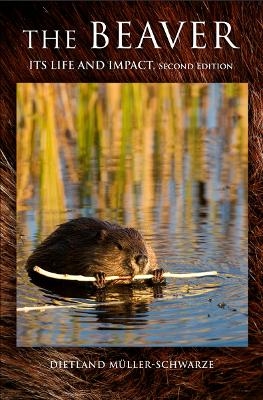
The Beaver
Comstock Publishing Associates (Verlag)
978-0-8014-5010-5 (ISBN)
Beavers can and do dramatically change the landscape. The beaver is a keystone species—their skills as foresters and engineers create and maintain ponds and wetlands that increase biodiversity, purify water, and prevent large-scale flooding. Biologists have long studied their daily and seasonal routines, family structures, and dispersal patterns. As human development encroaches into formerly wild areas, property owners and government authorities need new, nonlethal strategies for dealing with so-called nuisance beavers. At the same time, the complex behavior of beavers intrigues visitors at parks and other wildlife viewing sites because it is relatively easy to observe.
In an up-to-date, exhaustively illustrated, and comprehensive book on beaver biology and management, Dietland Müller-Schwarze gathers a wealth of scientific knowledge about both the North American and Eurasian beaver species. The Beaver is designed to satisfy the curiosity and answer the questions of anyone with an interest in these animals, from students who enjoy watching beaver ponds at nature centers to homeowners who hope to protect their landscaping. Photographs taken by the authors document every aspect of beaver behavior and biology, the variety of their constructions, and the habitats that depend on their presence.
Beaver facts:
•Just as individual beavers shape their immediate surroundings, so did the distribution of beavers across North America influence the paths of English and French explorers and traders. As a result of the fur trade, beavers were wiped out across large areas of the United States. Reintroduction efforts led to the widespread establishment of these resilient animals, and now they are found throughout North America, Europe, and parts of the southern hemisphere.
•Beaver meadows provided early settlers with level, fertile pastures and hayfields.
•Based on the fossil record, the smallest extinct beaver species were the size of a muskrat, and the largest may have reached the size of a black bear (five to six times as large as today's North American beavers). Beaver-gnawed wood has been found alongside the skeleton of a mastodon.
•Some beavers remain in the home lodge for an extra year to assist their parents in raising younger siblings. They feed, groom, and guard the newborn kits.
•In 1600, beaver ponds covered eleven percent of the upper Mississippi and Missouri Rivers' watershed above Thebes, Illinois. Restoring only 3 percent of the original wetlands might suffice to prevent catastrophic floods such as those in the early 1990s.
Dietland Muller-Schwarze is Professor of Environmental and Forest Biology at the State University of New York College of Environmental Science and Forestry. He is the author of The Behavior of Penguins: Adapted to Ice and Tropics, Chemical Ecology of Vertebrates, and Hands-on Chemical Ecology.
Preface
IntroductionPart I: The Organism
1. Now and Then: The Species, Including Fossils
2. Form, Weight, and Special Adaptations
3. Diving and Thermoregulation: From Land Mammal to Semiaquatic Design and Function
4. Energy BudgetPart II: Behavior
5. Families as Social Units
6. Communication by Scent and Sound
7. Infrastructure: Dams, Lodges, Trails, and Canals
8. Beaver Time
9. Food SelectionPart III: Populations
10. Reproduction, Development, and Life Expectancy
11. Population Densities and Dynamics
12. Finding a Home: DispersalPart IV: Ecology
13. Where They Live and Why: Habitat Requirements
14. Mortality and Predators
15. Parasites and Diseases
16. Maker of Landscapes: Creating Habitat for Plants, Animals, and PeoplePart V: Beaver and People: Conservation, Use, and Management
17. "Here before Christ": Fur Trade, the "Beaver Republic" (Hudson's Bay Company), and Fur Trapping Today
18. Reintroductions and Other Transplants
19. "Nuisance Beavers" Claim Their Land
20. Needed: An Ecosystems Engineer for Habitat Restoration and Other Services
21. Living with Beavers: Conservation and Proactive ManagementIndex
| Verlagsort | Ithaca |
|---|---|
| Sprache | englisch |
| Maße | 155 x 235 mm |
| Gewicht | 1361 g |
| Themenwelt | Sachbuch/Ratgeber ► Natur / Technik ► Naturführer |
| ISBN-10 | 0-8014-5010-1 / 0801450101 |
| ISBN-13 | 978-0-8014-5010-5 / 9780801450105 |
| Zustand | Neuware |
| Haben Sie eine Frage zum Produkt? |
aus dem Bereich


